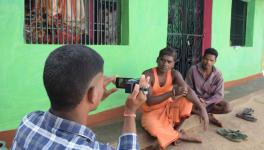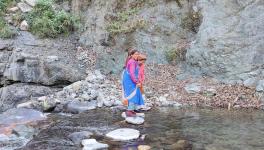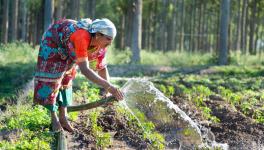Why Is Sustainable Development a Dream for India?
Report 8 of 2019 of the Comptroller and Auditor General of India (CAG), titled ‘Preparedness for the Implementation of Sustainable Development Goals, Union Government (Civil) NITI Aayog’ has finally been tabled after almost a month of delay. The audit assesses the government’s approach to implement United Nations General Assembly’s (UNGA’s) resolution ‘Transforming our World: the 2030 Agenda for Sustainable Development’. The resolution consists of 17 Sustainable Development Goals (SDGs) and 169 associated targets, to which India, being a member state, is a signatory.
CAG on Centre’s Vision & Strategy
The Audit finds that “a roadmap with defined milestones aligned with SDG targets to be achieved in the year 2020, 2025 and 2030, is however, yet to be prepared” by NITI Aayog. CAG goes on record to say that ‘Three Year Action Agenda’ covering the period 2017-20 mimics the dimensions of Agenda 2030 and preferred not to refer to SDGs; NITI Aayog also finds errors in sequencing documents, viz. “Three Year Action Agenda” covering the period 2017-20, a strategy document titled “Strategy for New India @75” covering the period up to 2022-23, and “15 Year Vision Document”. Report also adds that the documents fail to discuss the correlation of Government of India’s instrumentalised SDGs and that of Agenda 2030. This indirectly indicates that the pragmatic mapping of Goals and Targets in itself absent in the first place.
‘Speaker’s Research Initiative’ (SRI) workshops were organised in July 2015, August 2016, December 2016 and March 2017 to provide SDG-related insights to Members of Parliament, but CAG observes that SRI workshops have not been of help post March 2017. Also, “no centralised public awareness campaign was envisaged”. The audit raises concern that absence of dedicated awareness measures for general public may dilute the objectives of the 2030 Agenda. Furthermore, it comes to CAG’s knowledge that five out of fifteen ministries were yet to initiate any capacity building regarding SDGs.
CAG on State-level Adaptation of SDGs
States fail on the tests of formulation and mapping of SDGs and their realignment with states’ development indicators. West Bengal has not even started mapping of SDGs, Uttar Pradesh is also at a preparatory stage after four years of declaration of Agenda 2030. It is evident from the CAG’s report that there is a structural problem in Vertical Policy Coherence, i.e. failure of GoI to channelise the SDGs across the federal levels of cooperation. Several states like Chhattisgarh, West Bengal and Uttar Pradesh are yet to align budget for SDGs. The audit suffers when it comes to statistically analysing the situation as quality data are absent at State, District and Gram Panchayat levels.
CAG on Healthcare
Out of 17 SDGs, CAG only analysed Goal 3 [Good Health and Well Being] systematically. The audit’s observation on adapting Goal 3 spans some selected states and central government. It is found that several departments like AYUSH, Medical Education, Public Health Engineering, Home, Commerce & Industry and Environment are not mapped with Goal 3 in several states. Public Heath Expenditure in the narrow band of 1.02-1.28% of GDP may not sustain Goal 3, CAG remarks.
Also read: National Rural Health Mission in Shambles, What Does Budget Promise
CAG in a previous audit [Report 25 of 2017] on National Rural Health Mission has already expressed disapproval on the delivery of health services in rural areas. The report clearly showed the shortfalls in the availability of Sub-Centres (SCs), Primary Health Centres (PHCs) and Community Health Centres (CHCs) in 28 States/UTs. A NewsClick analysis highlights that the Muzaffarpur tragedy was foretold on these grounds.
Beyond CAG Audit
One shouldn’t forget that CAG is instituted by the government. In fact, government bodies hamper CAG’s independent functioning. Interference by the government in audits can’t be ruled out. Thus, subjects of audit also demand an independent investigation.
The CAG report only tackles the approaches of central and state governments in identifying and addressing parameters. It doesn’t look at each SDG in depth and that strictly comes out as a drawback of the audit. Human rights, gender equality and women empowerment find mention only once, that too in the overview paragraph of the audit.
SDGs are not only the parameters for boosting India’s internal development but also, they have the capability to be the vertebrae of India on a global platform where India is competing against Japan, Brazil and South Africa for a permanent seat in the UN Security Council. India’s contribution to UN Regular Budget for 2019 was just 0.8%, placing India on the 21st spot in the list of contributions. While India’s contribution to UN Regular Budget is insignificant compared to Japan and Brazil, which contributed 9.68% and 3.823% respectively, to the UN Budget 2016-18, the only criteria that can boost India’s status quo are its democratic and humanitarian values along with its military power.
India’s military assistance in UN’s peacekeeping missions is highly commendable but its democratic set-up is certainly under scrutiny after the publication of a 43-page report on Kashmir by the Office of the United Nations High Commissioner for Human Rights (OHCHR).
The report not only mentions grave abuses of power by armed forces but also discusses how political appointees have spawned hatred against Kashmiris following Pulwama episode. Quoting from Section I[128]: “On social media, individuals, journalists and even some political leaders were inciting hatred and violence against Kashmiri Muslims, people critical of the ruling Bharatiya Janata Party’s (BJP) Kashmir policies or those seeking accountability for human rights abuses in Jammu and Kashmir. In one instance, the Central Government-appointed Governor of Tripura state made a social media statement suggesting Indians consider a “boycott of all things Kashmiri”. No action has been taken against him or any others who incited hatred and violence against Kashmiris.”
Also read: United Nations’ Second Report on Kashmir Raises Tough Questions
A leaked UN report estimates that cereal prices may rise by 29% by 2050 because of climate change. The report reviewed by Nitin Sethi of Business Standard includes the critical findings of scientific researches which show that “in drylands, desertification and climate change are projected to cause further reduction in crop and livestock productivity, modify the composition of plant species and reduce biological diversity”. Chennai water crisis is just a signal; India’s approach to Goal 13, i.e. ‘Climate Action’ is thus defeating the purpose of the country which has more than half of the population dependent on agriculture. India has not taken any concrete steps to counteract the adverse environmental conditions. Ganga cleaning is still a political agenda and not a priority.
A 2018 survey conducted by the Thomson Reuters Foundation placed India as the world’s most dangerous country for women. In a previous write-up, it has been discussed how government refuting a foreign survey doesn’t compromise relentless abuse women face on a daily basis. The Sakshi-Ajitesh case is a fresh testimony to the fact that patriarchy is deeply entrenched in India. This obviously undermines SDG Goal 5 which encompasses ‘Gender Equality’. Goal 10 which is about ‘Reducing Inequalities’ again fails terribly in the Indian context where religious intolerance is on the rise and casteism is taking a modernised shape. By ‘modernised casteism’, the author means the westernised stratification of casteism where the sanskritic role of caste has undergone a transformation following British conquest and industrialisation. Now, casteism is not only restricted to a village structure but has engulfed the whole country with the advent of internet. This is not only fuelling widespread protests against cinematic experiments like Article 15 and Aarakshan but catalysing hatred among youngsters.
The steep rise in the cases of lynching attracted condemnations from the human rights organisations like Amnesty. Modi Government has cancelled Foreign Contribution Regulation Act (FCRA) licences of several NGOs which were working in the fields of human rights. NGOs critical of government have been on radar, prominent among them are Teesta Setalvad’s Citizens for Justice and Peace (CJP) and Indira Jaising’s Lawyers Collective. CAG, however, doesn’t mention the killings in the name of religion and caste nor has been the Ministry of Statistics and Programme Implementation (MoSPI) entrusted with the task of preparing hatecrime-monitoring indicators for SDG targets. There is sheer absence of willingness in the government machinery to control hate crimes. It is also believed that the perpetrators usually are close to the political stakeholders.
Also read: Increasing Carbon Emission and Sustainable Development
In such circumstances, it cannot be a way-out to say that the Government of India as well as its federal states lack apperception to impart Indians basic opportunity, respect and dignity guaranteed by Indian Constitution, let alone the insuperable Agenda 2030.
The author is an independent journalist and serves as an editor at Academia.edu. He writes on social inequality and rights in India. The views are personal.
Get the latest reports & analysis with people's perspective on Protests, movements & deep analytical videos, discussions of the current affairs in your Telegram app. Subscribe to NewsClick's Telegram channel & get Real-Time updates on stories, as they get published on our website.
























